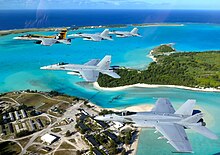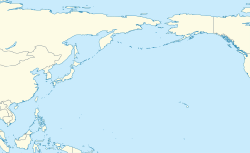
Back Pulo Wake ACE Wake-eiland Afrikaans Wake ALS جزيرة ويك Arabic Ueyk rifi Azerbaijani Уэйк Bashkir Wake BAR Wake Island BCL Уэйк Byelorussian Ўэйк BE-X-OLD
This article may require copy editing for grammar, style, cohesion, tone, or spelling. (October 2023) |
Wake Island
Ānen Kio (Marshallese) Isla San Francisco Halcyon Island | |
|---|---|
| Etymology: Named for 18th century sea captains | |
| Nickname: Wake | |
| Motto: "Where America's Day Really Begins"[1] | |
 Map of Wake Island | |
| Coordinates: 19°17′43″N 166°37′52″E / 19.29528°N 166.63111°E | |
| Administered by | |
| Status | Unorganized unincorporated territory |
| Territory | United States Minor Outlying Islands |
| Claimed by | |
| Claimed by the United States | January 17, 1899 |
| Claimed by the Marshall Islands | Oral tradition |
| Government | |
| • Body | United States Air Force (under the authority of the U.S. Department of the Interior) |
| • Civil Administrator | General Counsel of the Air Force PACAF Regional Support Center |
| Area | |
• Total | 13.86 km2 (5.35 sq mi) |
| • Land | 7.38 km2 (2.85 sq mi) |
| • Water | 6.48 km2 (2.5 sq mi) |
| • Lagoon | 5.17 km2 (2.00 sq mi) |
| • EEZ | 407,241 km2 (157,237 sq mi) |
| Highest elevation | 6 m (21 ft) |
| Lowest elevation | 0 m (0 ft) |
| Population (2017) | |
| • Estimate | 0 |
| • Non-permanent residents | c. 100 |
| Time zone | UTC+12:00 (Wake Island Time Zone) |
| APO / Zip Code | 96898 |

Wake Island (Marshallese: Ānen Kio, lit. 'island of the kio flower'), also known as Wake Atoll, is a coral atoll in the Micronesia subregion of the Pacific Ocean. The atoll is composed of three islets – Wake, Wilkes, and Peale Islands – surrounding a lagoon encircled by a coral reef. The nearest inhabited island is Utirik Atoll in the Marshall Islands, located 592 miles (953 kilometers) to the southeast.
The island may have been found by prehistoric Austronesian mariners before its first recorded discovery by Álvaro de Mendaña de Neira in 1568. Ships continued visiting the area in the following centuries, but the island remained undeveloped until the United States claimed it in 1899. Significant development of the island didn't begin until 1935 when Pan American Airways constructed an airfield and hotel, establishing Wake Island as a stopover for trans-Pacific flying boat routes. In December 1941 at the opening of the Pacific Theatre of World War II Japan seized the island where it remained under Japanese occupation until the end of the war in September 1945. In 1972, Pan American Airways ceased using the island for trans-Pacific layovers, instead using Boeing 747 aircraft, which could cross the ocean without stopping. With the withdrawal of Pan American Airways, the island's administration was taken over by the United States Air Force, which later used the atoll as a processing location for Vietnamese refugees during Operation New Life in 1975.
Wake Island is claimed by the Marshall Islands but is administered by the United States as an unorganized and unincorporated territory and is part of the United States Minor Outlying Islands. The island is administered by the Department of the Interior and managed by the United States Air Force. While there are no permanent residents, approximately 300 people are on the island at any given time, primarily military personnel and contractors.
The natural areas of Wake are a mix of tropical trees, scrub, and grasses that have adapted to the limited rainfall. Thousands of hermit crabs and rats live on Wake, and in the past, cats were introduced to help control the rat population, which at one time was estimated at 2 million. The Wake Island rail, a small flightless bird, once lived on the atoll but went extinct during World War II. Many seabird species also visit Wake, although the thick vegetation has caused most birds to nest in a designated bird sanctuary on Wilkes Island. The submerged and emergent lands at Wake Island are a unit of the Pacific Islands Heritage Marine National Monument.
- ^ Rauzon, Mark J. (2016). Isles of Amnesia: The History, Geography, and Restoration of America's Forgotten Pacific Islands. Honolulu: University of Hawaiʻi Press. p. 158. ISBN 978-0-8248-4679-4.
Wake island's motto—'Where America's Day Really Begins'—is a response to Guam, which claims that it is where America's day begins. In fact, the rising sun first shines on America at Peacock Point, the easternmost tip of Wake Island, which is just west of the international date line. If the motto sounds a bit defensive, that's only natural, for defense has always been the main purpose of Wake.

